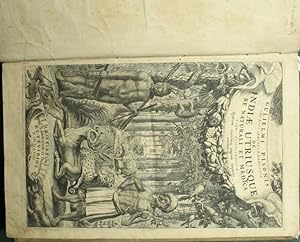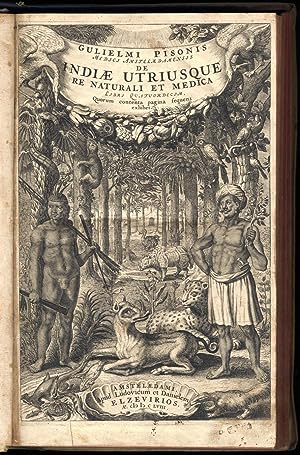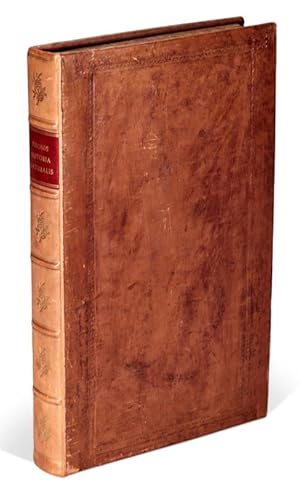Indiae Utriusque by Piso, Used (5 results)
Product Type
- All Product Types
- Books (5)
- Magazines & Periodicals
- Comics
- Sheet Music
- Art, Prints & Posters
- Photographs
- Maps
-
Manuscripts &
Paper Collectibles
Condition
Binding
- All Bindings
- Hardcover (3)
- Softcover
Collectible Attributes
- First Edition (3)
- Signed
- Dust Jacket
- Seller-Supplied Images (3)
- Not Printed On Demand
Free Shipping
Seller Location
Seller Rating
-
Gulielmi Pisonis medicj Amstelaedamensjs De Indiae utriusque re naturali et medica
Published by Apud Ludovicum et Danielem Elzevirios, Amstelaedami, 1658
Seller: Antica Libreria Srl, San Gregorio di Catania, CT, Italy
First Edition
Libri quatuordecjm, quorum contenta pagina sequens exhibet - in 4° - pp.11 cc. nn. + 327 + 2 cc. nn.; 39; 226 + 1 c. nn. - Pergamena - Tre parti in un volume - Frontespizio riccamente illustrato, finalini, capilettera, incisioni nel testo - Prima edizione - Frontespizio in parte staccato - Seguito da: Georgii Marcgravii de Liebstad Tractatus topographicus & meteorologicus Brasiliae, cum eclipsi solari quibus additi sunt illius et aliorum commentarii de Brasiliensium & Chilensium indole & lingua; Iacobi Bontii [.] Historiae naturalis & medicae Indiae orientalis libri sex . Commentarii, quos auctor morte in Indiis praeventus, indigestos reliquit, a Gulielmo Pisone in ordinem redacti & illustrati, atque annotationibus et additionibus rerum & iconum necessaris adaucti e Gulielmi Pisonis Mantissa aromatica; sive de aromatum cardinalibus quatuor, et plantis aliquot indicis in medicinam receptis, relatio nova - Libro usato.
-
De Indiae utriusque re naturali et medica, libri quatuordecim.
Published by Amsterdam, Elzevir, 1658
Hardcover. Condition: Very Good. Amsterdam, Elzevir, 1658. 11p, 329pp, 2p, 39pp, 226pp, 1p. Second edition, revised and enlarged, folio (346 x 214mm.), engraved title, approx. 650 woodcuts in the text, contemporary vellum. Borba de Moraes 676; Garrison-Morton 1825, Nissen (BBI) 1533; Sabin (America), 63029 "A PIONEER WORK ON TROPICAL MEDICINE and the largest work from the standpoint of format published by the Elzevirs" (Garrison-Morton). This work includes De medicina brasiliensi by Piso and Historia rerum naturalium brasiliae (including chapters on the natural history of Chile) by Georg Marcgraf (1610-1644). The work details the native uses of plants and animals for illnesses and provides the most extensive documentation of Brazilian flora and fauna in the seventeenth century. This is an extensively revised and enlarged second edition of Piso's Historia naturalis brasiliae (1648) with a new chapter by Piso on aromatic plants, and further chapters by Jacob Bontius, and approximately 150 additional woodcuts. The woodcuts include depictions of birds, animals, fish, plants, trees and reptiles. Piso was the first person to separate yaws (a contagious tropical skin disease) from syphilis and introduced the shrub ipecacuanha into Europe which was used as an emetic, diaphoretic and purgative.
-
De Indiae utriusque re naturali et medica
Published by Louis and Daniel Elzevir, 1658
Seller: Arader Galleries - AraderNYC, New York, NY, U.S.A.
Hardcover. Condition: Very Good. Amsterdam: Louis and Daniel Elzevir, 1658. Folio (345mm x 212mm): with an engraved title page, numerous woodcuts, woodcuts of plants with manuscript binomial classification. Bound in later calf with blind-tooled border, spine with raised bands in 6 panels, gilt decoration to the spine, sprinkled edges. Marginal tape repairs to index leaf, binding re-backed and slightly rubbed. Borba de Moraes II, 153; Sabin 63029; Willems 1236. Ex coll. Clayre and Jay Michael Haft; their sale, Sotheby's London, 12 December 2023, lot 112.
-
De Indiae utriusque re naturali et medica libri Quatuordecim
Published by Amsterdam: Lowijs III and Daniel Elzevir, 1658., 1658
Seller: Arader Galleries - AraderNYC, New York, NY, U.S.A.
First Edition
3 parts in one volume. Folio (14 4/8 x 9 inches). Engraved title-page, 522 woodcut illustrations and diagrams of fish, birds, plants, insects, and animals [Cleveland Collections count], woodcut tail-pieces and initials (engraved title-page nearly detached, without final blank at end of the first work, occasional spotting, some light browning). Contemporary vellum over paste-board, the spine in six compartments with five raised bands, brown morocco lettering-piece (worn with loss) in one (one or two pale stains). Provenance: with the ownership inscription of Giaco[mo] Soranzo (1686-1761), Venetian senator and bibliophile, on the front free endpaper dated 1720 (ownership inscription dated 1720); with the ownership inscription of Ranutii Aloysii Scarpacci on the verso of the front free endpaper; unidentified partially removed book label on the front paste-down. Second and enlarged edition the "Historia naturalis Brasiliae" edited by Johannes de Laet (Leiden and Amsterdam: 1648), which combined Piso's "Medicina Brasiliensi" and Marcgrave's "Historiae rerum naturalium Brasiliae". For this new edition, Piso decided to completely re-edit the two texts, and added de Bondt's "Historiae naturalis et medicae Indiae Orientalis" and his own "Mantissa aromatica". Marcgrave was initially commissioned by the Dutch West India Company to travel to north-east Brazil as an astronomer. Along with another student of medicine and mathematics, H. Cralitz (who succumbed to disease within a year of his arrival), and the physician, Willem Piso, he arrived in Brazil in 1738. Marcgrave travelled extensively, collecting all manner of plants and animals, before he was unexpectedly called upon to travel to Angola, whereupon he too died. So Piso returned to Holland with Prince Maurits, and without Marcgrave or Cralitz, but "laden with considerable collections of specimens and the confusing notes of Marcgrave. The astronomer had written his natural history findings in a cipher, purportedly to prevent Piso claiming credit for the work. Piso's contributions to the first edition of "Historia Naturalis Brasiliae" (1648) were contained in four books of 12 volumes, under the heading "De medicine Brasiliense", while eight volumes on botany and zoology were compiled from the material authored by Marcgrave. Johannes de Laet (1593-1649), director of the Dutch West India Company, decoded and edited Marcgrave's work for this edition, but when a second edition of the "Historia" appeared ten years later [as here] under the title "De Indiae Utrusque re naturali et medica", Piso carelessly made his own treatment of Marcgrave's work. For this he was severely criticised by, among others, Carl Linnaeus. "While both men obviously made remarkable contributions to the knowledge of Brazil's natural history, Marcgrave's work is considered in many quarters to exceed that of Piso in quality as well as quantity, despite his shorter years. A large map of Brazil produced by Marcgrave was also published posthumously in 1747. Indeed, after these explorations, nothing was written on Brazilian botany for more than 150 years except for the observations made by La Condamine in the mid-1700s. Although Rio de Janeiro was an international shipping port in the 17th and 18th centuries, few ventured beyond the city, largely thanks to the intimidating rule of Spanish and Portuguese administration" (Natural History Museum online). Arnold Arboretum p. 558; Borba de Moraes pp. 676-677; Cleveland Collections 225 (without Piso final blank); Garrison-Morton 1825; Hunt 280; Nissen IVB 589; Nissen BBI 1533; Willems 1236; Wood p. 520. Catalogued by Kate Hunter.
-
De Indiae utriusque re naturali et medica libri Quatuordecim
Published by Amsterdam: Lowijs III and Daniel Elzevir, 1658., 1658
Seller: Arader Galleries - AraderNYC, New York, NY, U.S.A.
First Edition
3 parts in one volume. Folio (14 x 8 4/8 inches). Engraved title-page, 522 woodcut illustrations and diagrams of fish, birds, plants, insects, and animals [Cleveland Collections count], woodcut tail-pieces and initials (some pale marginal waterstaining intermittently affecting later pages). Contemporary speckled panelled calf, the spine in seven compartments with six raised bands, red morocco lettering-piece in one, the others decorated with fine gilt tools (a bit rubbed, hinges weak) Second and enlarged edition the "Historia naturalis Brasiliae" edited by Johannes de Laet (Leiden and Amsterdam: 1648), which combined Piso's "Medicina Brasiliensi" and Marcgrave's "Historiae rerum naturalium Brasiliae". For this new edition, Piso decided to completely re-edit the two texts, and added de Bondt's "Historiae naturalis et medicae Indiae Orientalis" and his own "Mantissa aromatica". Marcgrave was initially commissioned by the Dutch West India Company to travel to north-east Brazil as an astronomer. Along with another student of medicine and mathematics, H. Cralitz (who succumbed to disease within a year of his arrival), and the physician, Willem Piso, he arrived in Brazil in 1738. Marcgrave travelled extensively, collecting all manner of plants and animals, before he was unexpectedly called upon to travel to Angola, whereupon he too died. So Piso returned to Holland with Prince Maurits, and without Marcgrave or Cralitz, but "laden with considerable collections of specimens and the confusing notes of Marcgrave. The astronomer had written his natural history findings in a cipher, purportedly to prevent Piso claiming credit for the work. Piso's contributions to the first edition of "Historia Naturalis Brasiliae" (1648) were contained in four books of 12 volumes, under the heading "De medicine Brasiliense", while eight volumes on botany and zoology were compiled from the material authored by Marcgrave. Johannes de Laet (1593-1649), director of the Dutch West India Company, decoded and edited Marcgrave's work for this edition, but when a second edition of the "Historia" appeared ten years later [as here] under the title "De Indiae Utrusque re naturali et medica", Piso carelessly made his own treatment of Marcgrave's work. For this he was severely criticised by, among others, Carl Linnaeus. "While both men obviously made remarkable contributions to the knowledge of Brazil's natural history, Marcgrave's work is considered in many quarters to exceed that of Piso in quality as well as quantity, despite his shorter years. A large map of Brazil produced by Marcgrave was also published posthumously in 1747. Indeed, after these explorations, nothing was written on Brazilian botany for more than 150 years except for the observations made by La Condamine in the mid-1700s. Although Rio de Janeiro was an international shipping port in the 17th and 18th centuries, few ventured beyond the city, largely thanks to the intimidating rule of Spanish and Portuguese administration" (Natural History Museum online). Arnold Arboretum p. 558; Borba de Moraes pp. 676-677; Cleveland Collections 225 (without Piso final blank); Garrison-Morton 1825; Hunt 280; Nissen IVB 589; Nissen BBI 1533; Willems 1236; Wood p. 520.





